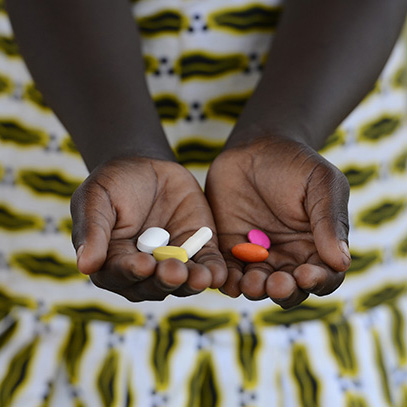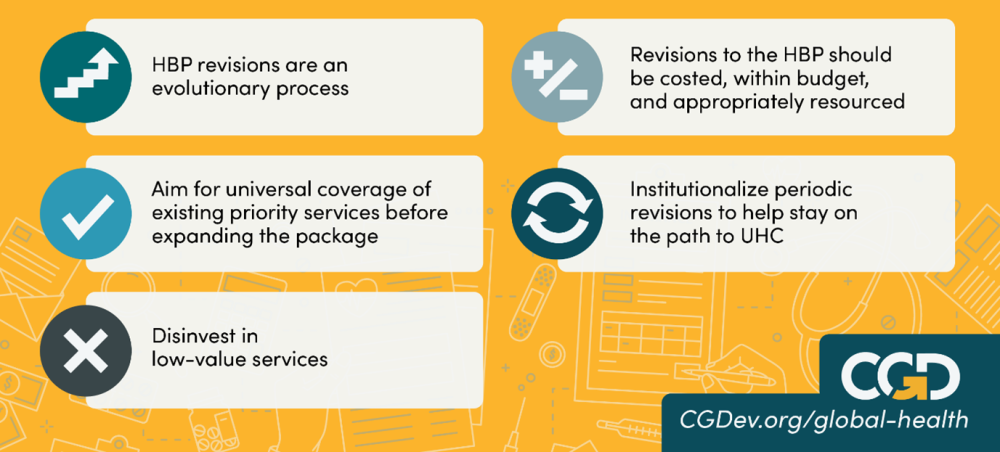Recommended

Event
On December 12, we celebrate countries’ efforts towards achieving Universal Health Coverage (UHC) and remind leaders of the importance of UHC and their promise of #HealthForAll. Yet this year, World UHC Day takes place against a backdrop of significant fiscal pressure stemming from changing economic prospects in many low- and middle-income countries (LMICs) as a result of multiple crises including the COVID-19 pandemic and the war in Ukraine. Now, more than ever, evidence-based, systematic priority setting will be essential to ensure that UHC programmes are financially sustainable and optimized to achieve health system goals.
Achieving UHC involves making choices about what services can be provided, to whom, and at what cost. The answers to those questions are the basis for designing Health Benefits Packages (HBPs). HBPs help countries make explicit commitments to their populations in terms of the health services citizens can expect; HBPs guide the delivery of care and associated resource allocation, including human resources, provider payment, procurement, and budgeting.
Once an HBP has been defined, it needs to be revised regularly to suit evolving health needs such as changing disease burdens, fluctuating budgets, and the emergence of new services, and to correct for implementation challenges. A HBP needs to be living instrument to help stay on the path to UHC. Yet in practice, we observe that HBP revisions are rare, even in countries with decades of implementation history.
Today the Joint Learning Network Efficiency Collaborative (JLN EC) released a new guide to support LMICs conduct a successful HBP revision, a work facilitated by the Center for Global Development, Radboud University Medical Center and the World Bank and co-produced with technical staff and decision makers from 14 JLN EC countries. The development of the guide follows the JLN ethos of placing countries at the heart of the scoping of technical projects, and learning and building from their experience to produce technical content; thereby bridging the gap between theory and practice. It aims to bring awareness about all the steps required to meaningfully revise a HBP, emphasizing the need for deliberative processes, stakeholder engagement, data, evidence collection and analysis, and policy dialogue with financial authorities.
Why are HBP revisions so important?
Regular revisions ensure that the HBP is up-to-date and delivered appropriately and that available resources are used efficiently and wisely.
Without regular revisions, the HBP becomes quickly outdated. This can mean resources are spent on services that are not the most cost-effective, whilst cost effective interventions are not covered. Both problems result in loss of health. For example, some countries might cover expensive dialysis services even though the coverage of essential health services is lacking. In addition, a survey conducted through the JLN EC showed that many countries struggled with the implementation of their HBP due to insufficient financial, human, and infrastructural resources to provide all included health services at desired coverage levels. Revisions, if done well, can address challenges in implementation, for instance, ensuring that the services are specified more clearly, costed, and matched to available budgets, or that rates set for the payment of providers are appropriate to adequately incentivize service provision.
Why are HBP revisions challenging?
HPB revisions are seen as complex and contentious, both from a technical perspective and a political/institutional perspective. Revisions can entail delisting and adding services, rate setting and updating (for the payment of providers), re-budgeting, changes in organisation of the package (e.g., nomenclatures), or changes in the population coverage (e.g., adding affiliates). From our JLN survey, we were able to define a timeline for development and revision of HBPs for some of the JLN EC members: this timeline (while not representative of all HBP experiences) shows that revisions are quite rare. To give one example: there was a thirty-year gap between the development of Sudan’s HBP and the first major revision. This finding echoes a recent review of HBPs. Few countries have legal or institutional provisions to update their HBP regularly. For instance, in Chile, the requirement to review AUGE’s HBP every three years has been inscribed in law.
Timing of initial HBP design and revisions per country

Five principles of revisions, which have been developed through extensive engagement with the JLN EC members, should be considered for successful HBP revision.
5 principles of HBP revision
Revisions are also best carried out when underpinned by a systematic, rigorous, transparent, and evidence-informed process with meaningful deliberation and stakeholder involvement. This requires time, commitment of dedicated human resources, and expertise to facilitate the process. A review of the experience from JLN EC members shows that revisions took between one month and four years to carry out; though it is worth noting that the country reporting one month also stated that the revisions were never implemented due to lack of stakeholder engagement and strong pushback following the announcement. This is an important lesson for donors and governments who often want to see revisions completed in unrealistic timeframes or without proper stakeholder engagement. It is not unusual, for instance, to see a request for proposals from consultants to deliver a new or revise an existing HBP to a country within a month.
Moreover, revisions require considerable technical expertise to conduct and considerable amounts of data and evidence: ranging from service utilization data, evidence on cost-effectiveness and equity implications of individual interventions, and extensive costing data. Yet few countries routinely collect such data and evidence. New resources, such as DCP3 and the Tufts CEA database are available to support this, but still require substantial technical skills to apply to the local context.
Developed by countries, for countries
The guide released today is the first resource to date that provides practical guidance for conducting legitimate HBP revisions. Experience from 18 LMICs sheds light on how they have organised their HBP revision processes, what challenges they have encountered, and best practices learned from implementation.
The resource is not meant to be a blueprint; rather, countries are encouraged to reflect on their own settings and challenges, and to customise the content. We also provide an extensive list of external resources (including available tools) and point to networks (e.g., JLN, iDSI, RED CRITERIA, RedESTA, and HTAsiaLink) that can be leveraged to facilitate peer-to-peer learning.
In publishing this guide, our goal is to support countries to plan effectively for the comprehensive process that underpins revisions, and to bring awareness of all of the steps to governments and stakeholders interested in revising HBPs. Through the three years of the JLN EC, we, as facilitators, learned tremendously from the rich experience of countries, which we believe is essential when working on a topic that requires on-the-ground learnings and first-hand experience of what has and has not worked well. Platforms to facilitate country peer learning and sharing of experience, such as the JLN, are particularly relevant to support this agenda.
Disclaimer
CGD blog posts reflect the views of the authors, drawing on prior research and experience in their areas of expertise. CGD is a nonpartisan, independent organization and does not take institutional positions.






